
Vol. 1, No. 1 Published by India China Division, Air Transport Command Jan. 18, 1945
On Record Made By ATC Glider C-46 Tows CG-4a Glider 1,320 Miles in 8 Hours; Previous Record 1,177 Miles 1306th BU, KARACHI - What is believed to be the longest non-stop glider flight on record was achieved by picked ICD personnel recently when a C-46 Commando towed a CG-4a glider 1,320 miles in 7 hours and 45 minutes. The flight was made from Karachi to a field in the Calcutta area. The previous unofficial record was 1,177 miles. The flight was made more dramatic by the last minute addition of 4,000 pounds of Christmas cargo. Since the flight was made Dec. 24, military personnel at a base ten miles from the field of destination received parcels they otherwise would not have gotten until after Christmas. Glider Can Carry 15 The flight demonstrated the distance a C-46 could tow a glider without the use of extra gas tanks. The limit still has not been reached. The problem of ferrying gliders to combat areas over long distances in a comparatively short time now appears nearly solved. Gliders in the past have been used in the invasion of Normandy and in Burma. The CG-4a is a cargo glider of Waco design. The load it can carry has little drag effect on the towing plane. This type glider is built to accommodate jeeps, light tanks, bulldozers, howitzers and items of similar weight and compact structure. When not hauling cargo, the CG-4a can carry 15 men, including the pilot and co-pilot. Veteran Pilot For the record trip the planes leveled off at 13,000 feet at the beginning of the flight, but severe cold brought the team down to 10,000 for most of the journey. The glider carried three pilots and the C-46 a crew of four. Piloting the latter was Capt. Paul J. Slayden, Nashville, Tenn., a veteran airman with more than 4,000 hours to his credit. Prior to entering the army he was on the Miami to Natal run for Eastern Air Lines. Co-pilot on the record run was F/O Ralph J. Coleman, Salt Lake City, Utah. Lt. George H. Heideman, South Bend, Ind., was the engineer, and Pvt. John P. Bolas, Chicago, Ill., the radio operator. Maj. R. W. Heartwell, Miami Shores, Fla.; Lt. Russell J. West, St. Joseph, Mo., and Lt. Solomon Schnitzer, Port Arthur, Tex., were pilots of the glider. |
World Leaders Commend Division After Plane Lands
In China Once Each 5 Minutes for 30 Days;
Once Each 2½ Minutes for 24 Hours
The greatest tonnage ever moved by regularly scheduled aerial transport was delivered to China by the India-China Division of the Air Transport Command in 1944.
In direct support of Allied tactical forces, the Division in twelve history-making months increased its operations more than threefold, and as a result its contribution to the Asiatic war.
Total tonnage delivered to the 14th Air Force, the XX Bomber Command and the Chinese armies cannot be revealed, but the following operational highlights are indicative of the impressive record made:
Shipments being flown over the Himalayas from India totaled 30,000 tons monthly by last November. By year's end, monthly tonnage to China was twice that of mid-year, three times that of the first of the year, and 3 times that of the first month of operations, December, 1942.
In one 24-hour period last fall, an ICD aircraft flew over the Hump every two-and-a-half minutes. In one 30-day period later in the year, a fully loaded transport landed in China from India every five minutes, 24 hours a day. At another operational peak, war materials were delivered over the famous mountain barrier at the rate of 2,600 pound a minute - fair weather and foul.
Clock-like Operations
In September - before ICD had yet reached its maximum operating efficiency for the year - the division moved 58 percent of the tonnage transported by all nine of the ATC's foreign wings.
The record for the greatest single day's Hump lift was eclipsed three times in the last six months of the year and each day's total tonnage was greater than the entire last month's.
The last three months of 1944, direct support of tactical forces increased greatly. To already heavy mail, passenger and cargo traffic were added large-scale troop movements. "Special missions" programmed from infrequent to routine, as battle locales shifted. Search-rescue activities increased accordingly as traffic over the Himalayas swelled. Air evacuation of casualties from forward areas became a substantial project.
In India, clock-like airline operations, comparable to Stateside, transported thousands of passengers, thousands of tons of cargo and thousands of pounds of mail monthly. Crew training, which of necessity had been chiefly in-flight only, became full time with outstanding results.
Accompanying such achievements were certain survey missions, inter-theater flights, historic hemisphere-spanning flights and other significant projects of far-reaching magnitude, revelation of which at present is forbidden for security reasons.
Such advancement reflected intensive expansion of personnel, augmentation of aircraft and extension of routes in India, Burma and China. The progress was achieved despite adverse weather, enemy interference and logistical problems which often handicapped operations.
The historic year began prophetically for the ICD with award of a Presidential Citation for an unprecedented Hump tonnage lift in December, 1943. The citation was the first to a non-combatant unit in this war.
To heavy tonnage commitments were added three great emergency missions in the first six months of 1944. These were the air-dropping of food, ammunition and medical supplies to the 17th Indian Division encircled by Japanese troops in Arakan early in the year; the short-notice transport of tons of gasoline, ammunition and tactical supplies to the Imphal Valley in the spring when three divisions of Japanese stood poised for assault in a surprise move looking toward invasion of India; and the emergency movement early in the summer of several thousand combat troops which had relieved the battle-weary Galahad forces at Imphal.
By mid-year, expansion of bases, personnel and aircraft had begun to make itself felt in steadily mounting tonnage figures. In March the organization's commander, Brig. Gen. Earl S. Hoag, was succeeded by Brig. Gen. Thomas O. Hardin; and the following month headquarters were moved from New Delhi to Calcutta.
New Records
On Aug. 1, the India-China Wing became a division of ATC. This transition was immediately celebrated by the greatest single day's lift over the Hump to that time. Tonnage exceeding the entire first month's operation was airlifted to China.
On Sept. 3, Brig. Gen. William H. Tunner succeeded Gen. Hardin as commanding general. Gen. Tunner, a West Pointer and former commander of ATC's Ferrying Division in the States, at once set into motion a vast operational program to meet staggering new tonnage commitments demanded by the quickening pace of war and the tactical situation in the Southwest Pacific, which was approaching an offensive peak.
The next 30 days witnessed further intensified expansion of every phase of the division's work. The first intra-China airline service was set up; troop movements to the fluctuating fronts in China reached an all-time high; China "turn-around" time was pared to the bone to expedite traffic; tactical evacuations were carried out in extremely unfavorable weather without a mishap, with Jap patrols a few miles away. In India, airline operations were augmented to handle mounting traffic from the States; bases were established with personnel, facilities and aircraft for direct four-engine operation to China; pilot, navigational and jungle indoctrination training went on a 24-hour basis.
|
End of 1944
The last three months of the record year overshadowed the entire first nine. In October, November and December, ICD moved 40 percent of the total tonnage transported over the Hump during the year.
Early October was marked by full measure delivery of excess-quota tonnage demanded overnight by the tactical situation, and by certain assistance to China-based combat air forces during the great Southwest Pacific naval battle - both projects being accomplished successfully, despite adverse operating conditions, by an outstanding pilot effort.
To meet such demands above normal tonnage quotas, all division sections - supply, personnel, operations, communications, engineering, briefing, intelligence, servicing and others - further intensified their operations and expanded their programs. On Oct. 8 the China Wing was established with headquarters at Kunming.
November - the division's record tonnage month - was ushered in by increasing "annoyance" interference from the Japs. Despite this, certain operational difficulties which naturally accompany rapid expansion, and the usual adverse weather in China, average daily tonnage increased 45 percent over the preceding 30-day period. The result of this all-out round-the-clock effort by pilots, ground crews and all ICD personnel was the greatest monthly tonnage ever air-lifted over the Himalayas by far.
Bengal Wing
Along with the record cargo movement, other special missions multiplied during the month. New airline runs, further shaving of China "turn-around" time, a record 'round-the-world flight in which ICD provided transport 50 percent of the way, and a trail-blazing inter-theater flight highlighted operations. On Nov. 15 the Bengal Wing was activated to facilitate long-range four-engine cargo operations. Two weeks later Forward Echelon headquarters were established in China.
The high pitch to which the division had become geared continued through December. Adverse Chinaside weather the first two weeks of the month slightly reduced the tonnage total. At that, pilots flew more than 10,000,000 miles to produce a just-below-record tonnage figure, ICD aircraft again making an average of nearly one round trip every five minutes during the month. The adage "China is not for the timid" took on greater meaning as personnel went on a full combat basis there. Alerts served to stimulate activity as survey flights to advanced forward areas were made, plans for augmentation of permanent aircraft for increased operations were completed, and general operational efficiency rose. In India personnel strained at every base to overcome the weather handicap the first part of the month, their efforts resulting in swiftly mounting tonnage figures following each ten-day period. One Assam base set a Christmas Eve operational high by flying each of its aircraft almost 20 hours that day.
On Jan. 1, 1945, ICD looked back upon a staggering increase in business during the preceding twelve months. With slightly more than twice as many aircraft it had moved more than four and a half times as many tons of war materials to China over the previous year.
To do this, it had increased its bases, its personnel and its facilities. This expansion had been unparalleled in aerial transportation history - often under pressure of not only the elements, mechanical difficulties and the enemy; but of time, that China might not be another case of "too little, too late."
New Rotation Policy To Give Stateside Furloughs
HQ., CALCUTTA - A new rotation policy governing ICD ground and flight personnel was announced last week.
Under the new set-up a key man ripe for rotation - 24 months of continuous foreign service or the required number of flying hours - is given two alternatives. He can request assignment in the United States, the procedure in the past, or he can ask for 30 days' leave at his home and then return to the division for another year's service or the required additional flying time.
Fly To States
A general policy for those who accept the 30-day leave has been outlined. Transportation by air will be furnished, to facilitate
|
24 Months Required
This new policy has been inaugurated to retain key personnel in this division, and selection of men for such leave is left to the discretion of the station commanders. However, final choice of the 30-day furlough is up to the man involved.
Eligible are flight personnel who have completed minimum requirements for rotation as specified in ICD Regulations 35-6 as amended. Administrative pilots and navigators and other administrative rated personnel have to complete 24 months' continuous foreign service before becoming eligible. Ground personnel also must have completed two years' continuous foreign duty.
Morale-Building Doc Lies Grounded in Own Sick Bay
1336th BU, ASSAM - Chairman of the morale board at this India-China Division ATC base is Maj. Ernest G. DeBakey, flight surgeon, and, as an upper bracket fish wrapper would say, therein hangs the tale.
As chairman of the board the youthful major whipped up a lot of interest in softball and got two leagues functioning. Also he presided over second base with professional aplomb on the team entered by the Medics. Came one of the crucial games of a waning season. Came also a tight ball game and a Pepper Martin slide into home plate by the doc.
Result: A fractured knee-cap and the doubtful honor of being the worst casualty of the season. To add insult to injury, the umpire missed the play by miles and waved the major out. The Medics dropped the nod by one run.
So, grounded in his own sick bay lies the wearer of the oak leaf, a victim of his own morale-building activities. Yep, morale is a lot of little things!
|
It's Banner Day At 1328th; Break Fifteen Records Commanding Officer Sets Pace With 3 Trips; Pilots Follow Suit 1328th BU, ASSAM - Selecting Dec. 24 as a banner day, this base broke just about every record in the book for one day's Hump operation. Fifteen division records are known to have been shattered, in addition to a half-dozen "probables." Records for individual trips be crew members and single aircraft went down in the course of the day's operations. Average loading, refueling and turnaround times were shortened considerably. More total hours, more miles and ton-miles were flown than ever before. A new time was set for crewing a plane and another crew set a new low for loading a ship. When it was decided, just four hours before the opening gun to attempt to make Dec. 24 an outstanding day in the history of the base and the division, air crews and ground crews threw themselves into the operation with all the energy and enthusiasm they could muster. With Maj. Claren U. Pratt, C.O., setting the pace, every individual worked harder and more feverishly than ever before. The C.O. himself made three Hump trips during the operational period. Three of his pilots tied him. An air of holiday spirit and a sense of the gigantic job they were doing pervaded the atmosphere. Ground crews swarmed all over the planes. Sergeants performed menial tasks and privates accepted responsible jobs in their haste to put the ships back into the blue. P and T loaded ships faster than they've ever been loaded before. Refuelers gassed 'em up faster than ever before. Turnarounds and inspections were accomplished in less time. In fact, everyone worked more efficiently than he ever had worked. The whole thing was on achievement of teamwork, organization and efficient application of "know-how" on the part of every man on the base. Adding more significance to the feat was the fact that it was a purely voluntary proposition. After Maj. Pratt and his staff had decided to try for a record, he told the men; and the men took over and did the job. Enthusiasm gripped the Indian help too! They were breaking their necks trying to feed men in a hurry at line mess ... and, believe it or not, an ox cart went trundling down the runway behind a brace of running oxen. At the close of the operational period, when many records had been shattered and a lot of supplies delivered to China, the report was presented to Brig. Gen. William H. Tunner. His appreciative reply was, "I could not have had a better Christmas present." |
Over Plane
C-87 Comes Out Second Best in Battle
With Twenty-Five Pound Bird
1330th BU, ASSAM - Fliers may have given "the bird" dozens of times, but it's doubtful if any ever got it more forcefully than Capt. Ray Y. Hoffman, Shamokin, Pa.
A 25-pound bird recently scored a technical knockout over the fully loaded C-87 transport the captain was piloting on a trip over the Hump.
Lost Half Control
Shortly after the plane had taken off, Captain Hoffman noticed the bird whiz past the cockpit window. An instant later the giant craft shuddered and the flier fought the controls as a violent vibration and tail flutter began.
The crew made a vain attempt to determine the damage by looking out through the astrodome. With about half the normal control lost, Captain Hoffman applied more power to maintain airspeed. Knowing the vibration could rip off the whole tail assembly, the pilot had to decide whether to bail out or ride the crippled plane down.
Landed Safely
He made the latter choice, returned to the base and made a high speed emergency landing successfully. The crew rushed out of the plane to have a look at the damaged tail surface and found that the bird had struck a vital point in the vertical and horizontal stabilizers. The "fracture" had set up a disturbance of the airflow as well as impairing mechanical control.
Other members of the crew on the flight defeated by the bird were Capt. Wilbert C. Dixon, Inglewood, Calif., co-pilot, Cpl. Edwin B. Small, Norfolk, Va., engineer, and Pvt. John W. Rowe, Denver, Colo., radio operator.
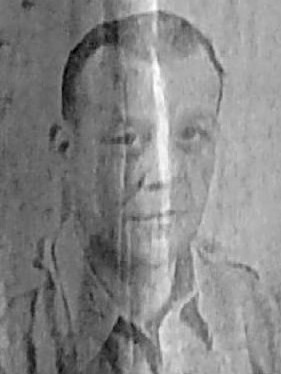
|
Much Sick Bay Equipment Improvised from
Salvage; Nurses and Beds To Be Real Thing
|
Recommendation of IBT Chief Nurse |
|
Dispensary Sick Bays In The Theater |
HQ., CALCUTTA - Things may be looking up - and prettier - for GIs convalescing in sick bays at ICD bases, as a result of a tour of a half dozen stations by Col. Edward A. Abbey, division surgeon, and Lt. Col. Agnes Maley, India-Burma Theater's chief nurse.
The officers inspected the sick bays with an eye toward determining need for Army Nurse Corps personnel. The chief nurse, who indicated she was favorably impressed with operation of the sick bays, said she would recommend that nurses be assigned to the installations.
Col. Abbey pointed out female nursing personnel is necessary for assistance in emergencies, for training GI medics in war management, nursing care and emergency treatment, for boosting morale when boys are sick and for treatment of WACs if they should be assigned to ICD bases.
The trip focused attention on the sick bays which in the first nine months of last year cared for 3,061 patients - and several bays have been established since that time. Worth of the establishments is indicated by the fact that the average number of days lost per case in ATC sick bays is 4.7, as compared with 14.7 in hospitals. Speedy discharge of patients is a contributory factor. Nine bays now have 280 beds.
The sick bays have taken the pressure off SOS hospitals by caring for less serious ailments and dealing with emergency cases in which lives frequently are saved. Col. Maley was intrigued by the ingenuity displayed by the ATC medics in improvising physio-therapy equipment and instruments not obtainable in the theater. The improvisers have concocted such vital apparatus as heat lamps, dental lamps and irrigation equipment from salvaged materials. One dispensary is air conditioned by a machine built of parts from broken down planes.
|
Instruments and equipment - sterilized and ready for action - always are kept on hand for major emergency operations and treatment of injuries received in crashes and other accidents. At isolated bases the dispensaries provide the only available medical care within a radius of many miles. Treatment of flying personnel by flight surgeons who are better acquainted with their ailments, as well as the slashing of red tape which customarily attends hospitalization, has saved many man-days of work.
ATC's dispensary sick bays were among the first established in the theater. They treat all American personnel on their respective bases, whether assigned to ATC or not. Each runs its own mess and carries on the functions of the larger hospitals. Until recently the sick bays got along with Indian cots and bedding, but a supply of hospital beds and mattresses which just arrived from the States will afford more comfort for the patients, according to Col. Abbey.
|
War Bond Sales Reach New High 1327th BU, ASSAM - War Bond sales soared to a new high at this base as officers and men bought $21,194.85 worth during December. Of the total, officers accounted for $5,536.25. Much of the credit for the successful bond push goes to the Personal Affairs section and illustrations painted by Pfc. Pasquale Brignolo, Dorchester, Mass. Lt. Col. Harry W. Gowins, CO, expressed his personal commendation for this enthusiastic support of the sixth war loan drive. |
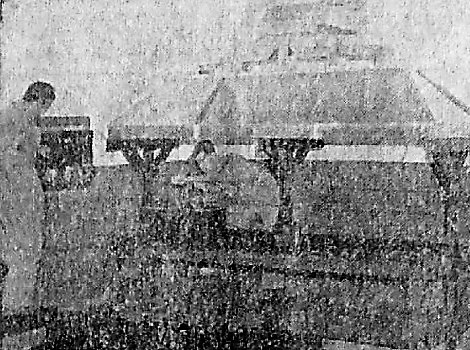 1306th BU - S/Sgts. Palmer and Lickert with their junk-built battery charger, latest contender for Yank-ingenuity honors.
Pvt. Hager, third member of the inventive trio, was absent.
1306th BU - S/Sgts. Palmer and Lickert with their junk-built battery charger, latest contender for Yank-ingenuity honors.
Pvt. Hager, third member of the inventive trio, was absent.
|
GIs Build Unique
Battery Charger
S/Sgt. Palmer, S/Sgt. Lickert and
Pvt. Haver Build Charger from
Salvaged Plane Parts
1306th BU, KARACHI - Three more candidates for the honor ....... stepped forward this week and modestly took a bow for a unique and rather ambitious battery charger. Constructed from equal parts of salvaged plane, natural mechanical ability and knowledge gained from previous experience with machinery and electricity, the apparatus will handle forty 12-volt or twenty 24-volt batteries at one time.
S/Sgt. William A. Palmer, who built the control panel for the charger, was an electrician with the Thomas Electrical Company, Corsicaria, Tex., before the President greeted him.
S/Sgt. Jack Lickert, formerly a sheet metal layout man with the Cincinnati Sheet Metal and Roofing Company, Cincinnati, Ohio, and Pvt. Orville T. Haver, who owned and operated his own sheet metal works in Meade, Kans., did the work on the gas escape duct.
The result is a compactly built unit which saves both time and money.
|
|
1347th BU, INDIA - "When the lights come on again all over the world" may well be the Allied watchword or merely lyrics to a popular ballad, but the line took on a new twist here recently, with emphasis on water instead of lights. It was great when the showers began to "make with the water" after a temporary drought.
The difficulty arose when the taps went dry, to conserve water as well as reduce malarial incidence. One of the unfortunates who got caught was Sgt. Vince Andrunas, Dorchester, Mass. - left well-lathered.
He was last seen walking stiff-legged to the ancient hand-pump, old reliable steel helmet dangling from a foamy arm.
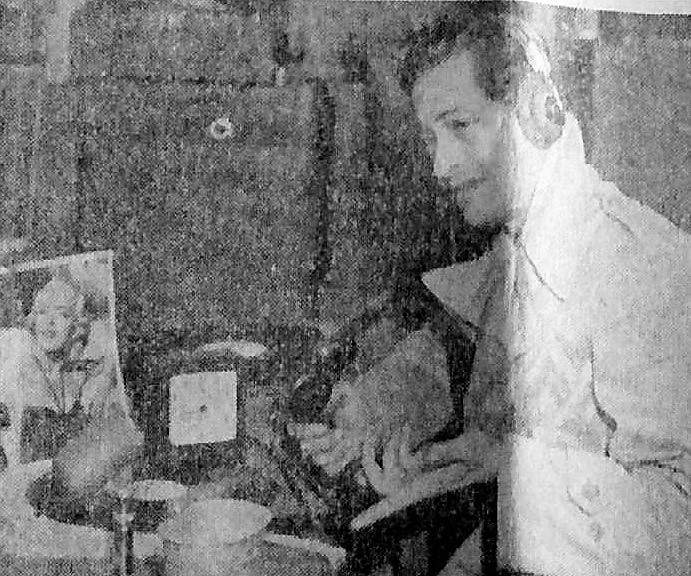 1333rd BU, ASSAM - It's 6:30 a.m. - time for the Pep Club - and the crazy antics of Cpl. Marion Moore, who would rather look at Lana Turner.
Before entering the service, Moore had a comedy role in "Hold On To Your Hats," which starred Al Jolson, Martha Raye and the CBI favorite, La Falkenburg.
Moore's part was that of a burlesque radio announcer.
1333rd BU, ASSAM - It's 6:30 a.m. - time for the Pep Club - and the crazy antics of Cpl. Marion Moore, who would rather look at Lana Turner.
Before entering the service, Moore had a comedy role in "Hold On To Your Hats," which starred Al Jolson, Martha Raye and the CBI favorite, La Falkenburg.
Moore's part was that of a burlesque radio announcer.
|
This Guy Cracks Jokes in Assam!
He Must Be Good
1333rd BU, ASSAM - A new feature of the Victor George radio station here is the early morning Pep Club with Cpl. Marion Moore at the controls. GIs in Assam now are awakened by a Tommy Dorsey swing record or a Hit Parade favorite instead of the CQ's flashlight.
Cpl. Moore, president of the Upper Assam Entertainment Council, begins the program with a "Brrrr, where's my coffee, bearer?" and an announcement of the time. After every record he gives the correct time and urges the men to get out of bed.
Adept in delivering GI humor, Moore's favorite introduction is "Good morning, friends - and officers, too." With gags such as this, Moore established himself as the top-ranking comedian in Assam after his successful GI show, "Take a Break for Laughs," the first of a series of shows produced by UAEC.
Resembling Bob Hope in appearance as well as wit, Assam's favorite comedian has added the Pep Club to his already numerous chores. Another recent addition is his "Words and Music" program, similar to the "Moon River" show. In civilian life Cpl. Moore broadcasted the "Moon River" program over Radio Station WLW, Cincinnati.
"And Bob Hope gets paid for this," laments the GI laugh-getter.
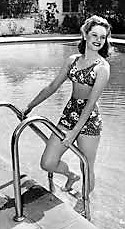 Warner Brothers' Alexis Smith is our cheesecake godmother. We feel that we could not begin our career under better auspices. In fact, we never
have seen any better auspices.
Warner Brothers' Alexis Smith is our cheesecake godmother. We feel that we could not begin our career under better auspices. In fact, we never
have seen any better auspices.
|
8000 Awards Are Received By
ICD Personnel in 1944
Five Soldier's Medals Given in December
to Four EM and One Officer
HQ., CALCUTTA - Five Soldier's Medals and two Oak Leaf Clusters to the Soldier's Medal were among an even 1,000 awards handed out by the division during December.
Lt. William F. Diebold, Cpl. Clarence Dorris, Sgt. Arthur E. Hawkes, and Pvt. Clarence E. Martin received the coveted medal for heroism displayed in parachuting into dense jungle to aid in the rescue of downed plane crews.
Pvt. Sterling Beswick got his Soldier's Medal for risking his life to rescue a fellow soldier from a flaming gasoline storage area.
The OLC to the Soldier's Medal went to Maj. William H. Spruell and Capt. Owen J. Morrissey for dangerous parachute jumps to give medical care to the survivor of a plane crash.
Other December awards were 359 Air Medals, 224 Distinguished Flying Crosses, 170 OLC's to the Air Medal, 196 OLC's to the DFC, 43 second OLC's to the Air Medal and one Purple Heart.
Figures recently released show that a grand total of 8,619 awards was made during 1944. Here is the breakdown:
|
Air Medal - 3,693
DFC - 2,334 OLC to Air Medal - 1,615 OLC to DFC - 754 |
|
Second OLC to Air Medal - 59
Third OLC to Air Medal - 1 Fourth OLC to Air Medal - 1 Silver Star - 3 |
|
Legion of Merit - 3
Soldier's Medal - 56 OLC to Soldier Medal - 4 Bronze Star - 74 Purple Heart - 17 |
Five Members of ICD Awarded Purple Hearts
Five Members of the ICD were awarded the Purple Heart on orders issued last week. The awards were made for wounds sustained during attack by enemy bombers on ICD installations. The five are 1st Lt. Harry H. Dearth, Jr., Sidney, Ohio; 1st Lt. Leo A. Huff, Elkhart, Ind.; Cpl. John F. O'Brien, Ventura, Calif.; Cpl. William C. Pierce, Muskegon, Mich. and Pvt. Newman H. Roe, Albertville, Ala.
|
Kirkland Brothers Meet Unexpectedly
In Burma Mess
1348th BU, NORTH BUMA - Things encountered in a GI mess hall periodically have been praised and as often condemned, until almost nothing remains unusual. But in the case of Pfc. Edgar L. Kirkland, Beaumont, Tex., one recent encounter proved as startling as a medium-rare steak in Burma.
Pfc. Kirkland was sitting in the mess hall when he was suddenly confronted by his brother, Vern, whom he had not seen for 2½ years. Vern, a private with a Combat Cargo group, had just missed a flight with his unit and strolled into the mess hall for a bite to eat.
Each brother knew the other was in this theater but had no idea of just where he was located. Edgar is with the refueling section of this base.
 Express Makes Bow
Express Makes Bow
This is the initial issue of "Hump Express," a weekly newspaper which it is hoped will become an integral part of the India-China Division of the Air Transport Command.
Purpose of the new publication is to furnish some recognition to the men who are flying bombs, gasoline, vehicles and a thousand other vital war items to China, those maintaining and flying ATC's vast military airlines in India, Burma and China, and others handling the search and rescue assignment and hundreds of other jobs requisite to accomplishment of the ICD missions.
The name of the paper was selected because the term "Hump" and the India-China Division have become almost synonymous, and "Express" denotes the job of the ICD in carrying passengers and other cargo from Karachi to the far reaches of China.
This newspaper will not duplicate the efforts of any other service newspaper in the India-Burma and China theaters, nor will it furnish worldwide spot news coverage. "Hump Express" will be a "family paper" - one which recounts the human interest items as well as the big news of air transport in the India-China operation.
Those working on the newspaper will try to maintain the human touch and turn out a publication which can be sent home to the relatives, to inform them of the job each of you is doing here to get the goods to China and help the Allies beat the Japs in that sphere. News in the paper is precensored, so that all ICD readers have to do is slip the paper in an envelope, affix proper postage and drop it in the mail.
Criticism and suggestions are more than welcome. If it is really to be an ICD newspaper, it's up to its readers to make their thoughts known. It is anticipated that a column devoted to "letters to the editor" will be instituted. Every effort will be made to turn out the type of paper that will be read and enjoyed by men of the ICD.
"Hump Express" will be published on Thursday of each week and will be flown immediately to every base in ICD. Papers should reach stations in time for distribution on the publication day.
ICD Record Is Good
ICD recently has been on the receiving end of some undeserved publicity in the press at home.
Not only was the publicity undeserved, but it was distinctly unfavorable to interests of the command.
A news release - which received widespread distribution not only in the daily press, but in "Time" and "Newsweek" magazines and over the radio announced dramatically in mid-December that there had been 300 cases of smuggling by military personnel between India and China from 1943 to 1944.
The India-China Division and aerial transport over the Hump are regarded as one and the same by the American public. However the news release did not differentiate among the other organizations which also carry on Hump transport operations to a lesser degree and which are scarcely known by the public, merely mentioning the now defunct Flying Tigers, "United States Army personnel," and certain civilians.
-Charges of a huge smuggling "conspiracy, of "the world's biggest black market" and branding of some pilots who fly the Hump as "low-grade scoundrels" blossomed forth in the U.S. press swiftly on the heels of the release. Because of its dominant position, ICD-ATC immediately was branded with the lion's share of the whole unsavory mess.
The facts of the Division's participation in contraband activities are:
Only SEVEN of the 300 cases listed involved ICD personnel. In four of these cases the officers involved were junior flying officers on detached service with the division from another command. The three other cases were of a minor nature involving a few cartons of cigarets and one small bottle of sulpha drugs. No evidence exists of ICD personnel ever having engaged in any organized smuggling conspiracy or black market ring of any kind. All cases were the result of actions of individuals at irregular intervals with no collusion with outside interests.
A strong protest was made by the commanding general with the request that a statement presenting the facts be given the widest distribution both at home and in the theaters the division embraces.
It was pointed out that the Command had exerted every effort to hold such violation to a minimum. That ICD had succeeded in this is illustrated emphatically by the extremely small number of individual cases.
Far from being drawn by inference into a situation so detrimental to its interests the division should have been commended for its record concerning such profiteering activities. Its reputation has been excellent in this respect.
It is the duty of every member of its personnel to see that it remains that way. The penalty for infractions is severe.
ICD has a clean record and a great reputation. Regardless of the severe penalties for smuggling infractions, no officer or enlisted man should wish to damage either.
|
It has been said commendations are good for the soul. It also must be remembered that commendations bring responsibilities which must be met.
A commendation is given for an achievement which is past. At the same time it demands further achievement in the future; for to have lasting meaning it must be lived up to. Progress never can "rest upon its laurels."
ICD during 1944 was commended highly by many of the world's great military leaders. Words of praise ranged from President Roosevelt's "Amazing - an epic of war," to Prime Minister Churchill's "Incredible feat of transport," and included statements from a score of world-famous figures: Chiang Kai-shek, Gen. Henry H. Arnold, Gen. Joseph W. Stilwell, Lt. Gen. Dan I. Sultan, Maj. Gen. George E. Stratemeyer, Maj. Gen. Harold L. George, Maj. Gen. Claire L. Chennault, Maj. Gen. Albert C. Wedemeyer, Maj. Gen. Thomas Hanley, Jr., Donald Nelson, and others. Early in the year the Command was awarded the Presidential Unit Citation.
The division is justly proud of this impressive recognition from leaders and Allies. Such comments speak well for its successes during a year which witnessed tremendous expansion, greatly increased support of tactical forces in China and general broadening of its overall mission, aerial transport of military supplies over the Hump.
But it must be remembered by every officer, enlisted man and civilian employee of the Command that far greater accomplishments are expected in the momentous months ahead. We cannot rest upon what we did last year. Last year is as old as yesterday's newspaper. This year - today - is what counts.
Tonnage figures will mount in direct proportion to the effort exerted by every member of the command - pilots, ground crews, desk workers and all.
Victory in the China campaign will come just that much quicker, as we push the war materials through.
Lots Going On
About this time last year, ICD was receiving a Presidential Citation for having transported over the Hump of the Himalayas, during the month of December, 1943, about 12,000 tons of military supplies for the use of Allied forces fighting in China. Now, each month, the total of such tonnage is about three times that amount. History had been made last January, and history has been made afresh in the interval.
Looking forward to January, 1946 - it will come, and will find many of us still here, unless a reasonable guess is far of the mark - who can say what miracles of aviation will be accomplished in furthering the Hump project and its associated missions?
We live in an age of accelerated history, and even in that age we of this decade are seeing a few years in which the acceleration is stepped up abnormally. Every passing day witnesses achievements and technical advances - going almost unnoticed against the background of epic war - which would have made headlines in quieter years we all remember.
Perhaps it isn't too Pollyannic to say that seeing some of this show, which will give no repeat performance, is some consolation for the discomfort, loneliness, danger and boredom of life here on the mossy side of the rock. The seat isn't upholstered, but it is up front.
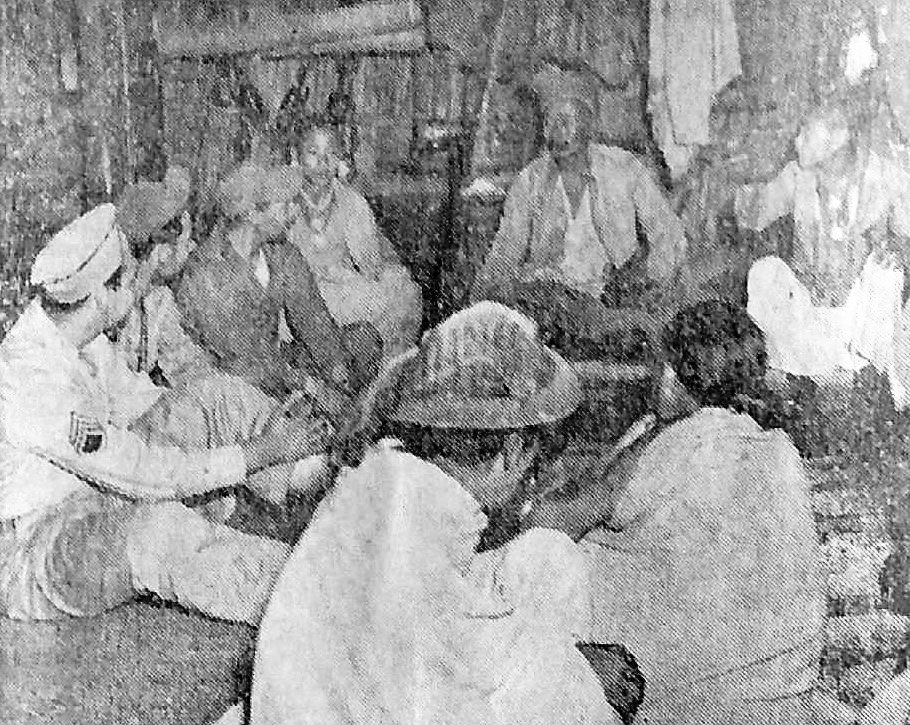 From Naga tribesmen in the Burma hills, downed airmen get a hearty welcome, much-needed help and quarters for the night.
The people of the Hump area have been found, for the most part, friendly, eagerly co-operative, and a valuable asset.
From Naga tribesmen in the Burma hills, downed airmen get a hearty welcome, much-needed help and quarters for the night.
The people of the Hump area have been found, for the most part, friendly, eagerly co-operative, and a valuable asset.
|
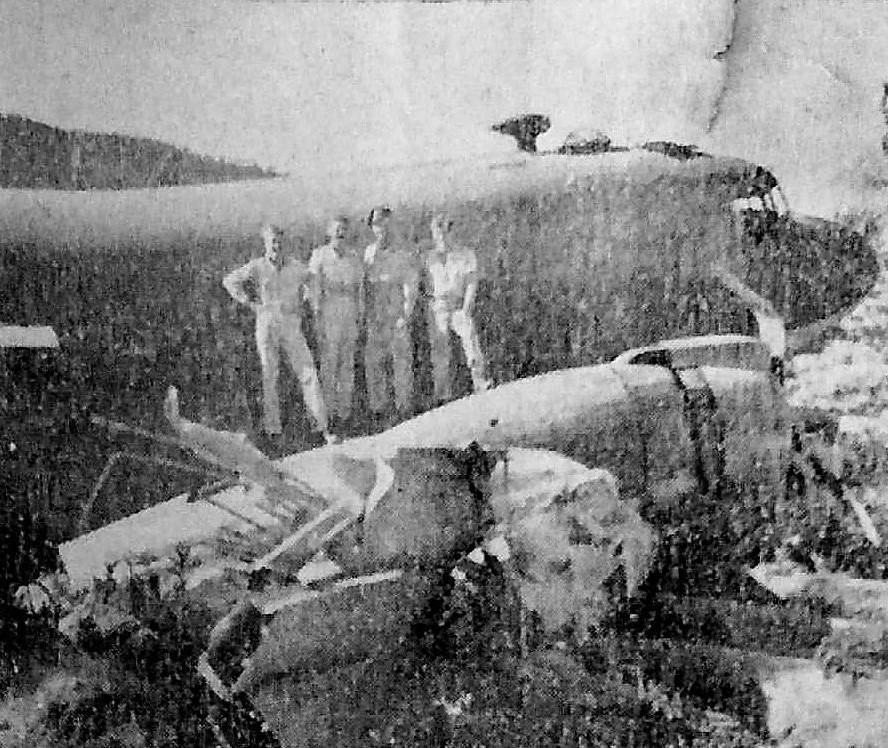 Four pioneers after a China crash during a search mission, in which masterly piloting saved every man. At right is their leader, the intrepid Capt.
John L. Porter, later killed in a B-25 search plane when attacked by about a dozen Japanese fighters.
Four pioneers after a China crash during a search mission, in which masterly piloting saved every man. At right is their leader, the intrepid Capt.
John L. Porter, later killed in a B-25 search plane when attacked by about a dozen Japanese fighters.
|
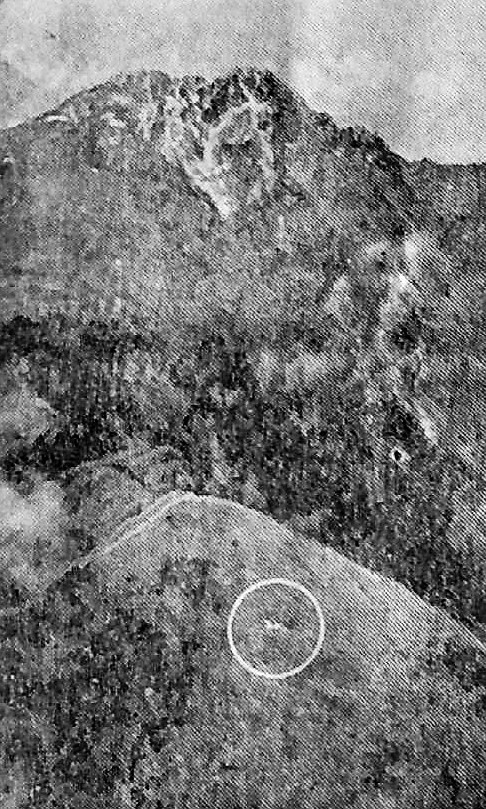 This shot conveys the incredibly rough terrain which is the province of Search & Rescue.
The wreckage which has been located, shown by the circle, is dwarfed to nothingness by the 4-mile-high peak it rests on, one of thousands.
This shot conveys the incredibly rough terrain which is the province of Search & Rescue.
The wreckage which has been located, shown by the circle, is dwarfed to nothingness by the 4-mile-high peak it rests on, one of thousands.
|
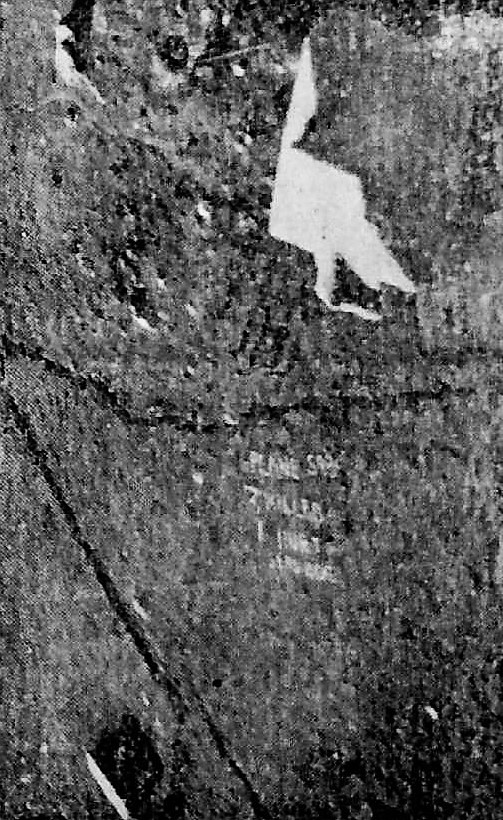 Panels dropped from a rescue plane spell out the story of tragedy for three crew members and request medical attention for a fourth.
A doctor will jump from the next plane with necessities perhaps including blood plasma or even whole blood.
Panels dropped from a rescue plane spell out the story of tragedy for three crew members and request medical attention for a fourth.
A doctor will jump from the next plane with necessities perhaps including blood plasma or even whole blood.
|
From thousands of square miles of jungle so dense than men may wander for days within the sound of each other's voices and be unable to join forces, and from the deepest gorges and highest peaks of Asia, the ICD's Search and Rescue Squadron now is bringing out to safety more than 75 percent of those who bail out or crash-land on Hump flights.
The squadron began, in a sense, when Hump flying began, but in the early days search for downed fliers was haphazard, limited by operational difficulties and lack of equipment. The famed "mass jump" of September, 1943, involving Eric Sevareid, of the Columbia Broadcasting System, several State Department representatives, and others, did much to stimulate innovation. Twenty of the 21 parachutists walked out alive, after a month of feverish anxiety. The innovations were retained and rapidly improved under the daring leadership of the late Capt. John L. Porter and his pioneering group, famed as "Blackie's Gang." Working hand in hand with Division Intelligence, they gradually spread through the Hump area a network of communications involving crew-sightings by regular Hump fliers, reports from aircraft warning stations, advice from combat supply and service units, and liaison with missionaries and other English-speaking residents, who in turn trained hill people to act as lookouts.
Fear of Jap interception and Jap ground patrols was a great bugaboo at the outset of Hump travel, as was lack of information on the native tribes, consequently dreaded. Today the tribesmen are known as mostly well-intentioned people, capable of genuine helpfulness to search missions, and the Jap menace has abated to the extent that the squadron may concentrate almost entirely on its ever-present enemy, the fearful terrain.
The photographs on this page, taken by ICD photographers, show some features of the thrilling work which goes on 24 hours a day to save the lives of scores of highly trained fliers sent out by ICD and other organizations to fly the Hump and forced down, by engine trouble or bad weather, in its "500 miles of hell."
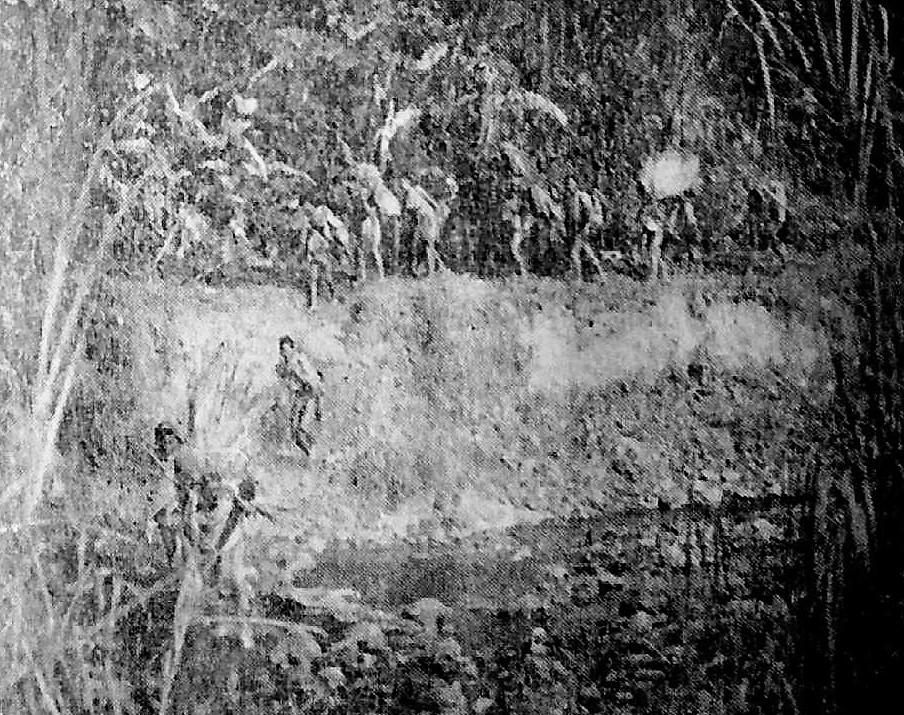 Burmese making their way through nearly impassable jungle with supplies needed by survivors.
Organization of ground parties to penetrate far into the jungle is a major duty of ground rescue officers at various
"Hump-Springboard" stations of ICD.
Burmese making their way through nearly impassable jungle with supplies needed by survivors.
Organization of ground parties to penetrate far into the jungle is a major duty of ground rescue officers at various
"Hump-Springboard" stations of ICD.
|
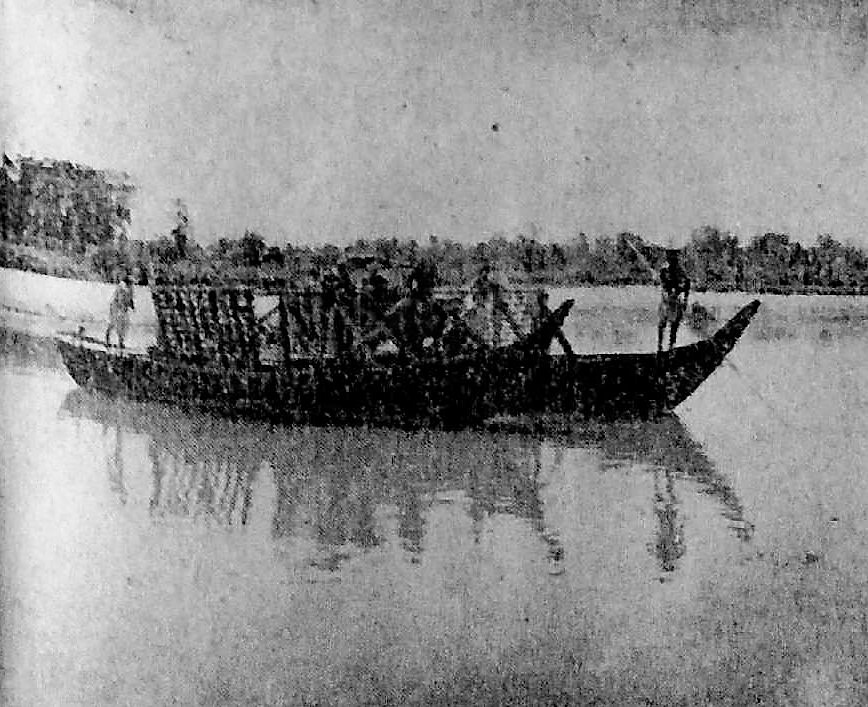 Across a river in Burma a jeep is ferried to help in bringing through the wilderness a party of searchers.
L-5's, bombers, horses, human backs, even a rubber life raft on one occasion, have been employed by searchers in bringing back bail-outs.
Across a river in Burma a jeep is ferried to help in bringing through the wilderness a party of searchers.
L-5's, bombers, horses, human backs, even a rubber life raft on one occasion, have been employed by searchers in bringing back bail-outs.
|
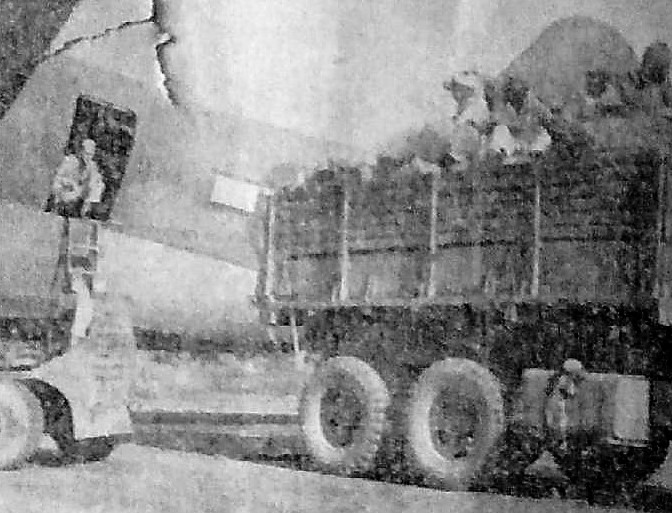 Ready to be piled into the waiting transport at the 1333rd BU, this mail will be at its destination in a few hours.
During Christmas rush and other especially busy days an entire plane load may consist of letters and parcels.
Ready to be piled into the waiting transport at the 1333rd BU, this mail will be at its destination in a few hours.
During Christmas rush and other especially busy days an entire plane load may consist of letters and parcels.
|
ATC Mail Terminals Handle 100 To 500 Tons of Mail Each Month
HQ., CALCUTTA - If a GI isn't getting his mail it's not the fault of ICD. Realizing that what a soldier wants most is his mail, the Priorities and Traffic section has given it a top priority and the division postal service has cut delivery time to a minimum.
Within 24 hours after the mail is sorted at one of the huge receiving terminals, it is flown to the remotest airstrip in China.
Handling all letter mail for all the forces in the India, Burma and China theaters, ICD is flying a tremendous tonnage of mail each month. In December, with the influx of Christmas mail more than one million pounds - 500 tons - of mail were hauled over the Hump. An ordinary month's tonnage runs a little over half that figure.
Handle 100 - 500 Tons
At Karachi and in Assam the ICD maintains two of the largest airmail terminals in the world. Truck-load after truck-load of mail is taken off one plane, speedily sorted and put aboard the next outgoing plane. In the course of a month's operation these terminals handle anywhere from 100 tons to 500 tons of mail apiece. Amount depends upon the arrival of mail in the theater. The unsteady arrival of mail often swamps these terminals with a backlog piled up in some other theater.
A well co-ordinated system of sorting and distribution has kept the mail flowing within the theater so that there is never a backlog anywhere in the division.
A close safe guard is constantly kept over each bag of mail and losses have been negligible. A recent aircraft accident in Burma brought out the efficiency of mail handling.
A C-46 loaded with Christmas mail for China caught fire in flight and the pilot made an emergency landing at a Burma base. As the plane struck the runway, the right engine was partially severed from its mount. A truck and cable were obtained hastily and the burning engine was yanked from the wing. With the fuselage still burning, the plane was towed the length of the runway. In the meantime a score of men had entered the blazing ship and feverishly tossed out the cargo. Not a single package or letter was destroyed, although the aircraft was almost demolished. As a result of this action 8,000 GIs in China got Christmas packages that otherwise would have burned.
Allotted Tonnage
Each month the India-Burma and China theaters are allotted a tonnage of incoming airmail via ATC ships. This tonnage governs the amount of mail coming from the U.S. to this theater by air. At present, the allotted tonnage rapidly is being increased. All outgoing letter mail is carried by ICD.
Col. Munson, Karachi CO, Air Transport Old Timer
1306th BU, KARACHI - When Russell W. Munson, recently promoted to full colonel, took command of the 1306th BU last October, the base fell under the direction of a CO well steeped in the business of air transport.
In ten years with United Air Lines Col. Munson was in turn a pilot, operations officer and coordinator in Washington, D.C. Over a six-year period he has held the army's counterpart of each of these jobs.
Col. Munson's airline history dates back to 1932. After getting his wings with the Army Air Corps and spending 16 months on active duty, he accepted a flying job with United in January, 1932.
Flying as a first officer and pilot, Col. Munson was given the San Francisco-Salt Lake run until 1938. He left this run to become assistant to the vice president in charge of United's operations.
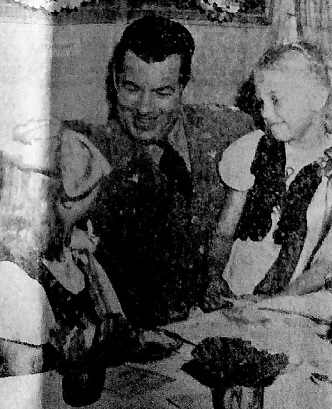 At a Christmas party given by the men of his base for Polish refugee children, Col. Russell W. Munson, CO of the 1306th, enjoys a chat with two
of the tots, who found him a ready and hearty friend.
At a Christmas party given by the men of his base for Polish refugee children, Col. Russell W. Munson, CO of the 1306th, enjoys a chat with two
of the tots, who found him a ready and hearty friend.
|
In Charge of Operations
Remaining with operations until August, 1938, Col. Munson then became United's coordinator in Washington, D.C. There he handled matters pertaining to regulatory bodies, such as new route applications, additional stops, rate cases or such other business as came before the Civil Aeronautics board.
When in 1941, he left this job to come into the army again, he went to Santa Monica and then to Long Beach, Calif., as assistant operations officer and later operations officer for the Sixth Ferrying Group.
For one year, beginning in June, 1942, he was operations officer for the Fifth Ferrying Group, Love Field, Tex. In June, 1943, he became deputy commander of the same outfit and later commanding officer for one year. At the end of the year Col. Munson was assigned to this theater and became CO of the 1306th in October.
Flies ‘Everything’
The easy-to-meet CO is a native of Chicago, but lived in Wyoming and California for many years. He attended Freemont County Vocational High School in Lander, Wyo., where he was active in sports. While at the University of Wyoming from which he was graduated in 1926, he captained the school's tennis team.
Early in 1929 he became interested in the Army Air Corps and enlisted as a cadet. He started his training at March Field, Calif., and after eight months finished his training at Kelly Field, Tex. During his "fledgling" days he flew such ships as PT-3As, DHs, O2Hs and Keystone bombers.
Since those early days Col. Munson has been flying just about everything the army and air lines ever had. At present he is a class 5 pilot. He received his senior pilot's rating Sept. 11, 1942.
Col. Munson is married and has a daughter, 11, and a son, 6. At present his family is living in San Marcos, Tex.
1347th BU, INDIA - A gale, which lashed this vicinity at a peak velocity of 75 miles per hour, inundated roads, soaked buildings, buckled basha roofs and stripped limbs from big trees, was not without its humorous sidelights as GIs and officers were awakened by the penetrating torrent. Cpl. Robert Bailey, of the AM squadron, wringing out soaked bed clothes under the leaking roof of his bashed basha, gave up the ghost after a dripping half hour and with Tennessean disregard for the elements finished his interrupted sleep on the porch. T/Sgt. Robert Beers, Bloomsburg, Pa., had one of the beat groans of all. "To think I broke my back yesterday cleaning all those duds," he moaned as he dejectedly surveyed the muddied wreckage sagging on the bamboo clothesline. But there's always one in every crowd who snores right on, oblivious to it all. This time it was S/Sgt. Ray Maher, classification specialist, of Chicago, who calmly slept through the storm. |
Harlem to Jive-Loving GIs
1330th BU, ASSAM - "Rhythm and the Blues," Negro USO troupe that played at this base recently and is currently appearing at other ICD bases, presents a headline cast that brings a bit of Harlem to a jive-loving GI.
Traveling in trains, jeeps and aircraft, the troupe is making a maximum of stops and giving as many performances as possible at each base. The performers arrived here in time to give three shows and half a dozen appearances at a local hospital.
Top blues number, "If I Could Be With You," is done by Alberta Hunter who emcees and leads the show. "Taps" Miller, composer of "Hold Tight," "Wham" and "Hot Dog," takes the male lead of the show. His trumpet playing, dance routine, and special renditions of his own compositions score him tops with lovers of Harlem jive.
The "Three Rhythm Rascals" from Club Cafe Society, Chicago, round out the male part of the cast. Ollie Crawford, guitar, Alfred Elkins, bass viol, and Leonard Caston, pianist, are the "Rascals." Torch singer of the show is Mae Gaddy, formerly a vocalist with Don Redman and Cab Calloway.
Banshees Are Helping ICD, AAF Reveals
80th Fighter Group Disclosed As Unit Providing Hump Run Protection
HQ., CALCUTTA - The AAF Eastern Air Command recently revealed that the fighter group patrolling the Hump area, protecting the ICD cargo routes, is the USAAF 80th Fighter Group, popularly known as the "Burma Banshees."
The 80th's job is primarily one of affording protection for the ICD's unarmed cargo planes and for Allied bases in Assam and northern Burma, the approaches to the Hump route.
Enemy Damage Drops
With the advent of the "Burma Banshees" in the summer of 1943, the number of cargo planes shot down and damage to bases by enemy aircraft became almost negligible.
Up to mid-December, 1944, the 80th had intercepted and shot down 58 Jap aircraft out to harass the air routes. In addition they destroyed six Jap planes on the ground, with nine other planes probably destroyed. On occasion they also have bombed and strafed Jap supply dumps, bivouac and staging areas and vital installations, besides being a constant threat to Jap communications in North Burma.
Commended By Tunner
Under the command of Lt. Col. Albert L. Evans, Jr., the group's pilots have flown more than 50,000 hours, dropped some 20,000 bombs, and fired more than 4,000,000 rounds of machine-gun ammunition.
Brig. Gen. William H. Tunner, commended the job of the 80th thus:
"Thanks to the fighters we have been able to increase our pay-loads into China while decreasing our losses of airplanes, crews and cargoes."
|
Hump Fliers To Figure in Movie Called ‘Calcutta’ Trials and tribulations of the Hump flier soon will receive world-wide attention in a new Paramount production, "Calcutta." Selected as the locale of the drama because of its seething war time activity, the city of Calcutta will come to light in its role of military hub of operations in this area. The screen play will revolve about the adventures of a group of colorful aviators, famous for flying over the Hump to China. The picture will not concern itself totally with the war but will depict the color and intrigue of the great East India city. Written to be produced by Seton I. Miller, it will resemble "Casablanca" in its general outline. Premiere showing is scheduled for next summer. |
Graduating Flight Traffic Clerks
To Receive Diplomas
HQ., CALCUTTA - Handsomely printed diplomas will be awarded to GIs completing the five-day course of instruction at the ICD Flight Traffic Clerk school, Agra, it is announced here by Capt. M. M. DeGroff, director.
Recipients will include 76 successful members of the first four classes, who have now returned to their bases.
Numerous reports from Priorities and Traffic officers at the various bases have lauded the work of the Agra school, which opened Nov. 27. Its three-fold purpose is to secure uniformity in passenger handling, to improve service and to promote clarification of the problems faced by the men who have the difficult assignment of being the military equivalent of peace-time airline stewardesses.
The diplomas are scheduled for initial distribution during the first week of February.
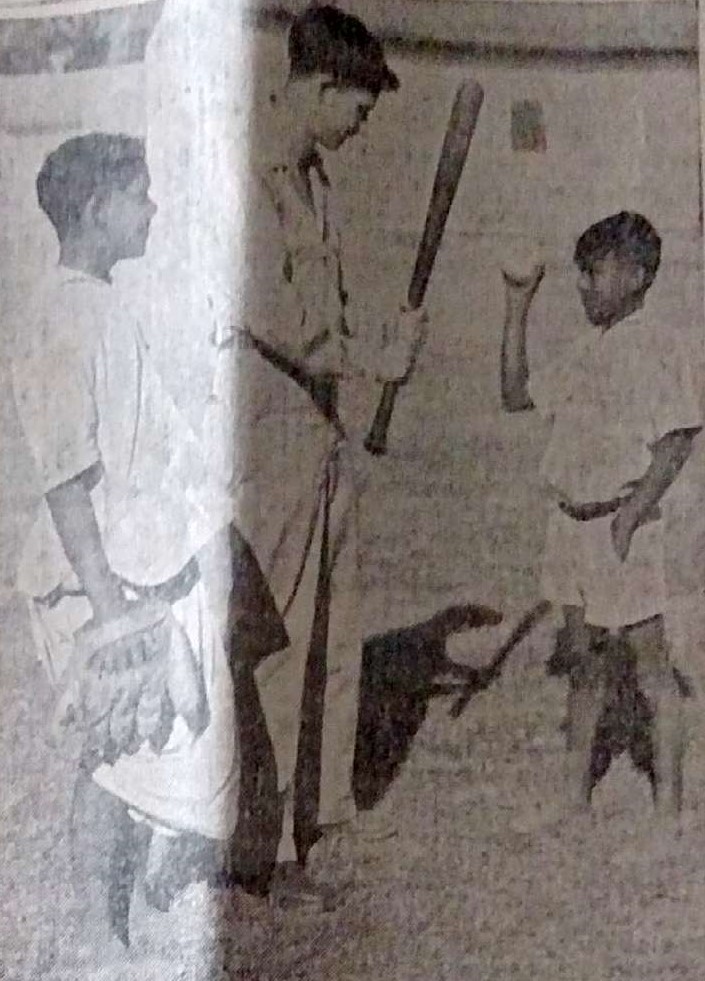 1311th BU, INDIA - Two young Indians pick up some fine points of the American national sport at an athletic field of ICD. Their instructor is Pvt.
George A. Gunsaules, Garwood, N.J.
1311th BU, INDIA - Two young Indians pick up some fine points of the American national sport at an athletic field of ICD. Their instructor is Pvt.
George A. Gunsaules, Garwood, N.J.
|
Former California Welterweight
Title Holder Would Like To Put
On a Few Bouts for IC Division
|
Texas Boxer Started Ring Career Taking On Any and All Comers |
1347th BU, INDIA - This base, currently engaged in getting its new cargo planes in first class shape for the long haul over the Hump, boasts a former welterweight champ, Cpl. Ocie (Killer) Dearing, of Fort Worth, Tex., one-time West Coast title holder.0
Now 21, and working in the base motor pool, the chunky, India-sunburned leather-pusher started in the "racket" at 15, in a carnival out of Lufkin, Tex. "Twenty bucks if yuh stay tree rounds wit 'The Killer'," the barker rasped, and the kid took on any and all comers.
Won 32 Out of 35
A year with the carnival made him adept at rough-and-tumble, but he made his entry into the pro ring via the usual route - neighborhood gyms and country canvasses and until the war put a temporary rein on his dukes. Dearing had rolled up a pretty good average. He had dropped but three out of some 35 pro bantam bouts, had mixed it with ringwise, world title contender Jackie Wilson, split a brace with 'Irish' Johnny Taylor, and beat Abe Baber for the California welter crown.
Asked about his roughest time, Dearing broke into a grin, mentioned a flight officer at Tyndall Field, Fla.
"Used to give him boxing lessons," he recalled in a soft Texas drawl, "and maybe I smacked him a bit too hard. Anyway, he got my fanny up in an AT-6A that night and turned me every way but loose!"
Dearing started to laugh then, his friendly face showing surprisingly few signs of ring wreckage. "Man," he muttered softly, "I never mussed that boy up again!"
Recommends Bouts
Dearing agreed that the hard-hitting India-China Division could use a few equally hard-punching bouts.
"There's a terrific job being done here by ground and aerial crews alike," the fighter said. "What they need is maybe some relaxation after a mission over the Hump, or a hard day's work on an engine, or getting the records straight in some office."
Killer Dearing would like to get the ball rolling on some boxing bouts, would be more than happy to take the first match, either exhibition or otherwise. He weighs in around 160 now, has been doing a little roadwork and sparring, and feels that he could handle a fast six-rounder. Any takers?
Here’s One For the Book
1337th BU, ASSAM - "It shouldn't happen to a dog," the baseball team at the 1327th BU must be moaning these days.
It all started on a recent Sunday when one of the sports oddities of the year was unreeled. Twenty tired, dirty softballers from the 1337th jumped off a six-by-six at the 1327th for what they expected to be a hot game. But they learned that there was no softball team on the base - that they only played baseball and had "the best ball club in India" with a record of 44 wins and 7 losses.
Regardless of the odds, the boys from the 1337th decided to beard the lion in its den and take on the hosts at their own game - hardball - for a practice tilt.
"Silent Nick" Ciossi strolled out to the mound and teased the opponents along, with three hits in his five innings on the mound. Then Nick gave way to "Big Jim" Griffith, who denied the 1327th hardballers as much as a loud foul.
Before the string was played out, the bats of Gregory, Hermsen and Bennett asserted themselves enough to push over four more runs, to make the final tally 5 to 0, with the veteran baseballers on the short end of the score and the softballers feeling mighty chesty about the whole freak affair.
1306th Out For Court Title
Fifteen-Man Basketball Team To Try for Mythical All-India Crown
1306th BU, KARACHI - To provide opportunity for every basketball player to participate, three divisions of hoop competition have been set up at this base.
In the top division, the ATC Humps, 1 15-man squad representing the 1306th has dropped one and won one in two practice games. The Humps are gunning for the Malir league championship and a chance to compete in the Shaughnessy playoff which follows. Winners of the playoff will meet the Karachi city champs, and the best team goes to New Delhi to try for the mythical All-India title.
A second league of six teams forms the "A" or squadron league and is restricted to inter-squadron teams. Similar to intramural sports, the "B" league is open to any department or group of men on this base.
|
Weather Squadron Quint Takes Lead In Softball Race 1305th BU, CALCUTTA - The Weather squadron aggregation has captured first-half honors in the 1305th softball league race, nosing out the Priorities and Traffic team. The two had been tied with two losses and one win each on completion of the initial round of league play. Respective managers, Sgt. Cliff Gates, of Weather, and Capt. Joe Kowalski, of P and T, are girding for the second half and an all-out battle for the pennant. Should any dark-horse contestant get into the money, no one will be more surprised than the two confident leaders, who have been eyeing each other suspiciously before game times since the league play began, trying to dope each other's strategy. |
Athletic Field Is
Named For Ex-CO
1305th BU, CALCUTTA - Completion of Skannal Athletic Field, announced this week, is a major contribution to the sports program of this base.
The field boasts a softball diamond, two basketball courts, three badminton courts, a horseshoe pit and punch-bag stand.
It is named for the 1305th's former CO, Lt. Col. Charlie F. Skannal.
|
 Here is the departmentalized laundry in Assam. At left is the marking section which gives the GI an even chance of getting his own clothes back.
A revolving stamp was made from tire patches and an old de-icer boot. Next is the engine-driven washer, fashioned from a salvaged fuel truck and gasoline
drums. After laundering, the clothes go to the pressing room. Here charcoal-heated irons are seen, but the dry cleaning department boasts a Stateside
electric presser. At the right is the sorting and packing section where the bundles are placed in racks made of bucket seats from salvaged aircraft.
Here is the departmentalized laundry in Assam. At left is the marking section which gives the GI an even chance of getting his own clothes back.
A revolving stamp was made from tire patches and an old de-icer boot. Next is the engine-driven washer, fashioned from a salvaged fuel truck and gasoline
drums. After laundering, the clothes go to the pressing room. Here charcoal-heated irons are seen, but the dry cleaning department boasts a Stateside
electric presser. At the right is the sorting and packing section where the bundles are placed in racks made of bucket seats from salvaged aircraft.
|
Dhobi-Style Laundry Plans Junked When Homemade Washer Is Built |
|
Cleaning Fluid, Electric Iron Make Assam Dry Cleaning Plant |
1328th BU, ASSAM - ATC is operating its own modern GI laundry in Assam. For four rupees a month all military personnel may have any amount of clothing washed in a gasoline-driven washer under sanitary conditions.
The establishment was made possible through the ingenious use of salvaged materials - from the improvised washing machine to the use of old motor oil for heating fuel.
Located on a site originally intended for use as a dhobi-style laundry, the original buildings and water troughs have been incorporated into the present set-up. Various departments of the laundry now are housed in some of the original buildings. The troughs form part of the rinsing system. In addition, a basha has been taken over for an office and sorting room, and tents have been pitched to house other sections of the laundry.
21 GIs Employed
Marking, washing, drying and ironing make up the various departments of the laundry, headed by 2nd Lt. James W. Ryan, with S/Sgt. Adam Kessler NCO in charge. Working in these various departments are 21 enlisted men and 35 civilians.
In processing, a bundle of clothes is taken to the marking room, where it is marked and checked against the soldier's list. Bins receive the clothing to await washing.
Next the clothes are placed in the washer operated by a gasoline engine. Attached to a shaft which runs through the center of a 600-gallon tank are three 50-gallon gasoline drums perforated so the water can circulate. The clothes are placed in these drums which revolve inside the large tank of hot water, drained after each washing.
Maintenance Improvises
Then they go to the drying section where they are hung out to dry in the sun and then folded or taken to the ironing room for finishing. All clothing is sorted alphabetically and then bundled for delivery.
S/Sgt. William Russell is charged with maintenance of the laundry. To this section belongs much of the credit for improvising the modern plant. His department helped design and build the washing machine out of a tank from a burned-up gasoline truck and discarded gasoline drums. The engine was taken from a broken water pump. The marking section had trouble marking the clothes until Maintenance hit upon the idea of a revolving stamp. The finished product was almost Stateside in appearance, despite the fact that the letters and numbers were cut from tire patching and glued to a piece of rubber from a deicing boot.
Dry Cleaning Too
At first charcoal was used for heating the irons and for other heating purposes. As this caused much soot and dirt, a heating system was devised so waste oil could be burned.
Another feature of the laundry is a dry cleaning service operated from a tent, with a genuine Stateside electric iron for pressing. The clothing is dipped in a cleaning fluid if it's very dirty, otherwise it is sponged only. In either case, the cleaning job is a good one - for Assam.
The laundry is one of the features of the base. Every visitor makes it a "must see." It is interesting for what has been done with so little and the use to which discarded material has been put.
|
Christmas for Remote Posts By Parapack Boxes Sent by Californians Dropped Out of Planes By Chaplain HQ., CALCUTTA - It took an airplane and parachutes to enable ICD to wish a Merry Christmas to GIs at remote Burma hill outposts. The greetings took the form of 54 Christmas boxes, packaged by California women in a project sponsored by Mrs. J. L. Cruze of Los Angeles, mother of Sgt. Robert G. Woolston of the division Staff Judge Advocate section. Lt. Col. Paul W. Schrope, division chaplain, assisted in arrangements for distribution. Flying out of the 1333rd BU, Assam, on Dec. 23, Chaplain Orvil Unger and a crew from the Search and Rescue squadron traveled over the inaccessible outposts which serve as air raid warning and spotter stations for Assam bases and dropped the boxes in parapacks by 'chute. With each pack went a letter from the squadron expressing appreciation for services. Chaplain Unger said it was like extending the men below a personal greeting as he kicked the packs out of the aircraft door and watched as the men ran after and opened them. The chaplain believed the gift boxes would be more appreciated by men at the outposts where they couldn't make frequent trips to well-stocked PXs than by others nearer "civilization." Then packages distributed by parachute from the 1333rd were a portion of 1,077 boxes sent by Mrs. Cruze to ATC chaplains from India to Alaska. A total of 41 cartons, containing 457 boxes of assorted items - combs, soap, tooth brushes, playing cards, candy, books - was sent to ICD bases for distribution to men who needed them most. Mrs. Cruze and her assistants began work on the project last summer and by late August had most of the cartons in the mail. In addition to the gifts, which required hours of wrapping, the Californians wrote personal greeting letters to the unknown and unseen GI recipients. Among the messages were those from ex-screen stars, ranchers and a good cross-section of the California populace.
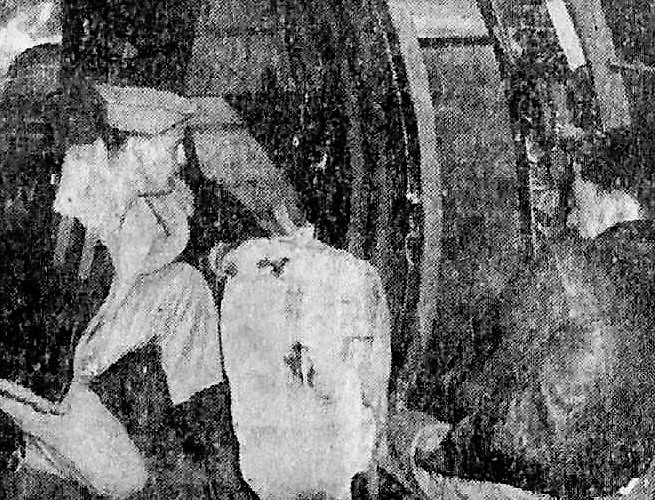 1333rd BU, ASSAM - As a C-47 flies over a remote Burma weather station, Chaplain Orvil T. Unger, acting as ATC's Aerial Santa Claus, prepares to drop a bag of Xmas
gifts, containing packages donated by California women in a project sponsored by Mrs. J. L. Cruze, of Los Angeles.
1333rd BU, ASSAM - As a C-47 flies over a remote Burma weather station, Chaplain Orvil T. Unger, acting as ATC's Aerial Santa Claus, prepares to drop a bag of Xmas
gifts, containing packages donated by California women in a project sponsored by Mrs. J. L. Cruze, of Los Angeles.
|
Big Names Are Just Routine
to Terminal Clerk
Passengers Going Through This Base Exceed
the Number At LaGuardia Field
1340th BU, CHINA - Sgt. Bertrand R. Parent, Fall River, Mass., finds his army job very much to his liking these days. Since he arrived in the division he has been serving as a passenger terminal clerk with the China Wing.
The number of passengers handled daily at this terminal, ranging all the way from United Nations generals, ambassadors and cabinet members to army privates, both American and Chinese, exceeds that of LaGuardia airport.
Sgt. Parent's duties are to board a plane on arrival and inform the passengers as to their whereabouts. He then conducts them to the terminal office for screening, and thence to chow and quarters should this be their destination. In the case of outgoing passengers he takes them to the plane and sees that their parachutes and oxygen masks are properly adjusted before takeoff.
He has a simple formula for seeing high-ranking U.S. officials and popular film celebrities. "You don't have to go to Washington or Hollywood," he says. "Just stick around. Vice-President Wallace, Donald Nelson, Ann Sheridan, Pat O'Brien, Maj. Melvyn Douglas - sooner or later, they all come through. See that fellow over there? He's the lucky guy who adjust the 'chute on Jinx Falkenburg."
There probably are few GIs in the ICD who wouldn't drop their typewriters or wrenches for a crack at Parents' job of rubbing elbows with big wigs all day long.
Assam ‘Stars’ Get Pay Raise
1330th BU, ASSAM - The Treasury Department might be interested in one paragraph of the latest special orders issued from this headquarters. Named as privates first class, and drawing an extra $4.80 a month from now on, are Bonnie Bennett and George Burns. The "notables" had no comment to make on this conspicuous salary boost.
Three Pilots in Wrong Trench
1340th BU, CHINA - At least three pilots of this base have learned that there are trenches and trenches.
During a recent air raid the three ran like mad for a deep slit trench - they thought! Then their noses told them a different story.
Result: three unhappy fliers, with many "best friends" to tell them in case they didn't know, and a pointed suggestion from all concerned that personnel be oriented in the respective positions of slit trenches and straddle trenches.
IN A HURRY: The HUMP EXPRESS, only official newspaper of the India-China Division, enjoys some sort of distribution superiority over most other newspapers in the world. On the same day that it rolls from the presses, and almost while it is still "warm," the EXPRESS is loaded aboard aircraft which speed it to the four corners of three different countries - India, China and Burma - to every base operated by the ICD.
One Thousand Signaling Mirrors for Jungle Kits
One thousand emergency signaling mirrors have been delivered during the past two weeks for use of personnel regularly flying the Hump. They will be included in the standard jungle kit.
This initial shipment of the ingenious signaling device has aroused widespread interest. Tried and found extremely effective elsewhere, it is expected to prove of special value in the Hump territory, where smoke signals are almost useless because of the innumerable fires kept alive day and night by the mountain people. Owing to confusion with these constant fires, few, if any, smoke signals ever have resulted in the finding of a ground party in Hump jungle, according to ICD's Search and Rescue squadron.
The mirror is also far superior to code panels now in use, as a means of initially attracting attention, though not of expressing specific needs. Its maximum range is ten miles, a distance far greater than can be hoped for from any panel arrangement practicable under emergency conditions in wooded country.
The 4 x 5 inch device has an aperture through which a cross-shaped beam of light penetrates, and part of the reverse side is another mirror surface. When a passing aircraft is sighted through the cross and the small mirror shows the cross-shaped beam reflected by the hand of clothing and coinciding with the aperture, then the large glass is directed halfway between sun and airplane, and its powerful beam is aimed directly at the plane.
HUMP EXPRESS is the official newspaper of the India-China Division, Air Transport Command, APO 192, c/o Postmaster, New York, N.Y., and is published by its Public Relations office. Camp Newspaper Service and Army Newspaper Service features are used, reproduction of which is prohibited without permission of CNS and ANS, 205 East 42nd St., New York, 17, N.Y. Other material is submitted by staff members, ICD-ATC base Public Relations sections and other soldier correspondents. Printed weekly by the Hindusthan Standard, 3 Burman St., Calcutta, India, and distributed each Thursday. Passed by U.S. Press Censor for mailing.
| Military transport schedules over India for cargo, personnel and mail ... maximum tonnage of essential war materials over the Hump ... movement of troops and supplies in support of tactical operations in China ... evacuation of the sick and wounded - these are the missions of ICD-ATC. |

JANUARY 18, 1945
This page dedicated in memory of CBI veteran Carl Maurice Ward
Original issue of HUMP EXPRESS shared by Jerry Harper
Copyright © 2017 Carl Warren Weidenburner
TOP OF PAGE PRINT THIS PAGE ABOUT THIS PAGE E-MAIL YOUR COMMENTS
FINAL ISSUE HUMP EXPRESS BASE NEXT ISSUE
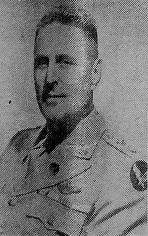
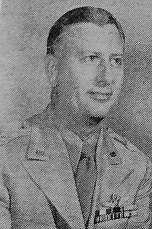
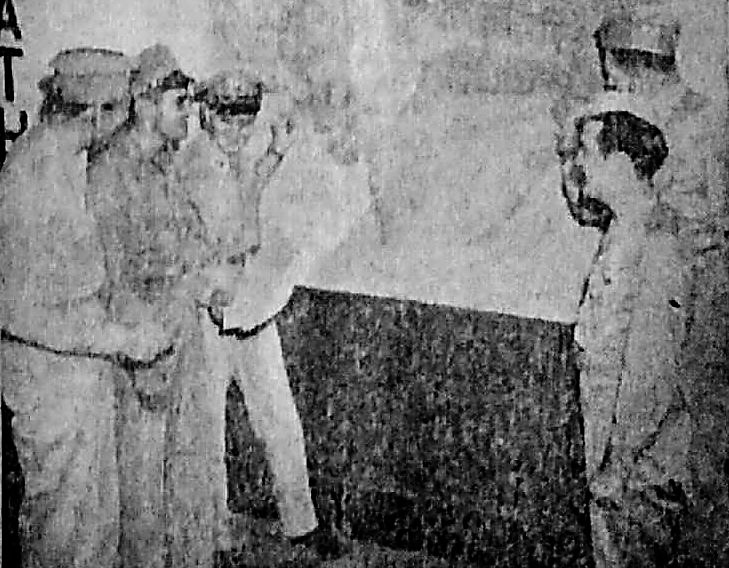 1306th BU, KARACHI - Some members of the crew which took part in the record towed-glider flight measure the distance on a map.
Left to right are Maj. R. W. Heartwell, F/O Ralph J. Coleman, Capt. Paul J. Slayden, Pvt. John F. Boles and Lt. George H. Heideman.
1306th BU, KARACHI - Some members of the crew which took part in the record towed-glider flight measure the distance on a map.
Left to right are Maj. R. W. Heartwell, F/O Ralph J. Coleman, Capt. Paul J. Slayden, Pvt. John F. Boles and Lt. George H. Heideman.
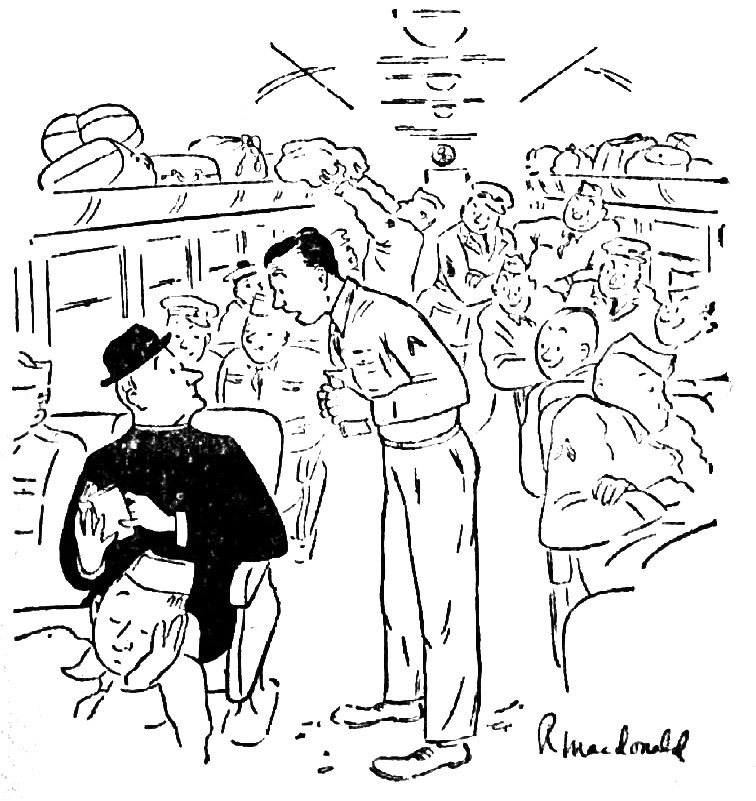 "We were wondering if you'd mind moving to one of the other cars, sir. Some of the boys thought they'd like to sing."
"We were wondering if you'd mind moving to one of the other cars, sir. Some of the boys thought they'd like to sing."